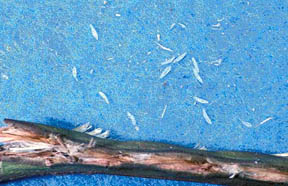Periodical Cicada | |
|---|---|
| September 11, 2007 | |
|
Periodical cicada eggs should be hatching at this time in northern Illinois where the adults were present. The adult female cicada inserts her eggs into branches, appearing to prefer pencil-sized twigs. The eggs are laid in clusters deeply into the wood of the twigs and remain there for several weeks. These eggs are white, slender, elongate ovals and are about 1/8 inch long. As the egg develops, the black eyes of the developing nymph become obvious through the chorion, the outer surface of the egg. Just before the time of hatching, the head, legs, and segments of the abdomen are visible through the chorion as it becomes increasingly thin and transparent. The hatching nymphs are white, about 1/16 inch long, and covered with hairy setae. They are similar in appearance to the nymphs that emerged from the soil in the spring except that they appear more elongate, as well as being different in color and size. They emerge from the egg-laying slit made by the female, crawl to the edge of the twig, and free-fall to the soil below. Once reaching the soil, the nymphs use their enlarged, shovel-like front legs to dig through the soil until they reach a suitable root. Feeding primarily occurs between 8 and 12 inches below the soil surface, an area that contains many tree and shrub roots. They feed by sucking sap from the roots, occasionally changing roots if the root dies, for 17 years in the northern half of North America. These babies will emerge as fully grown nymphs, ready to change into adults. It is interesting to consider that human babies born this year will be nearing adulthood at the same time as these insects. Twigs and branches with eggs laid into them frequently die. Lateral buds below that area will break next spring, with attacked trees and shrubs being bushier due to the extra shoots that these buds produce. Over the next few years, these extra shoots will be self-pruned from the plant, and the plant will return to its previous appearance.  Periodical cicada eggs and damage. Belowground, the large number of nymphs will reduce in number due to predation, disease, starvation, and other mortality factors until about 30 per cent of the eggs that are laid survive to emerge as mature nymphs in 17 years. These sucking insects have little effect on their host tree or shrub when they are young and small, using very little sap to sustain them. However, numerous, older nymphs do cause a reduction in the width of annual rings in tree trunks during the couple of years before an emergence. This impact is not enough to cause serious health problems for the tree or shrub, but it has allowed researchers to trace back many generations of cicadas by studying the tree rings of old trees. The next emergence of periodical cicadas in Illinois will be the Great Southern Brood, Marlatt’s XIX, in 2011. This 13-year brood will emerge throughout most of the southern two-thirds of Illinois. It covers the largest geographical area of all periodical cicada broods: large areas of Illinois, Missouri, Arkansas, Mississippi, Alabama, and Georgia, along with parts of Iowa, Kentucky, Indiana, Louisiana, Tennessee, South Carolina, North Carolina, and Virginia. The brood that emerged this year, the Northern Illinois Brood, Marlatt’s XIII, will emerge again in 2024. Hopefully, the sub-brood in the Chicago suburbs will also be back. It should emerge in 2020. Expect to see a few periodical cicadas next year and a very few in 2009. There are always a few stragglers that emerge 1 or 2 years late, as well as a few 1 or 2 years early. These few cicadas are typically eaten by birds and other predators soon after emergence. With these cicadas not living long enough to reproduce, their numbers do not grow into broods. |